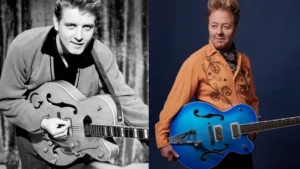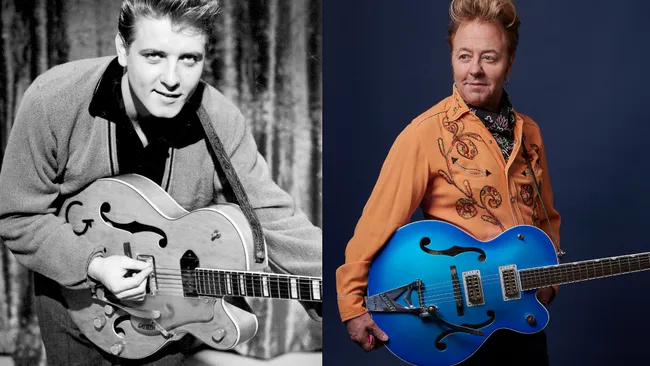 About Gretsch guitars, Brian Setzer stated, “Those things still bring me the most fun out of anything,” in an interview with Gary Graff for Guitar Player in 2023. However, he continued by saying that it was because of one musician, Eddie Cochran, that he initially developed a deep affection for the Gretsch brand.
About Gretsch guitars, Brian Setzer stated, “Those things still bring me the most fun out of anything,” in an interview with Gary Graff for Guitar Player in 2023. However, he continued by saying that it was because of one musician, Eddie Cochran, that he initially developed a deep affection for the Gretsch brand.“I bought one in the late 1970s because I wanted to look like Eddie Cochran;” says Setzer. “I had no idea if they would sound decent. I found one in the local paper for $100 because nobody knew who Eddie Cochran was back then.
Cochran, who played a Gretsch 6120 Chet Atkins hollowbody guitar, was an unavoidable presence on the hit parade some twenty years prior as one of the guitarists most essential to the original wave of rock & roll. Cochran, who was born in America, became well-known on both sides of the Atlantic thanks to late 1950s singles including “C’mon Everybody,” “Summertime Blues,” and “Twenty Flight Rock.” The Beatles and the that were among the artists that praised his music, but Cochran passed away in a horrific taxi accident in Bristol on the evening of April 16, 1960, long before either band ever made an appearance. The following day, he passed away. His travelling companions were even luckier: Cochran’s girlfriend, songwriter Sharon Sheeley, who co-authored his own 1959 smash song “Somethin’ Else” and wrote successes for Richie Valens and Ricky Nelson, and his friend, rocker Gene Vincent.)
As rock and pop became increasingly sophisticated in the 1960s and 1970s, Cochran’s memory faded into the past, but Setzer stayed enamoured with his music, which he had first heard as a child in the 1960s. During a cameo performance of “Summertime Blues” in the 1987 Richie Valens film La Bamba, he even had the opportunity to play the rock star.
We felt it was appropriate to talk to Setzer about Cochran’s impact on his guitar tone, music, and image, given how Gretsch guitars have influenced his sound and how he has revolutionised the brand with his line of signature models. He was more than willing to comply.
Before you discovered Eddie, were you already a fan of 1950s rock & roll, or was he your introduction to the genre?
Although it was primarily doo-wop, which is obviously fantastic music, my parents enjoyed 1950s music since they were from New York. However, I discovered that Eddie Cochran was somewhat unknown, particularly to audiences in later years when only a few of his songs were well-known. It was like a whole new world when I found Eddie; I was like, “Now this is what I’m talking about!” [laughs]
Isn’t the image a major component of the great rockers of the 1950s’ appeal?
Yes, without a doubt. To be honest, I thought, “Oh my god, I want to be that guy!” when I saw his reissued album The Legendary Masters hanging up in my neighbourhood record store. Even before I heard the music, I knew I wanted to look like that guy since it was the coolest appearance. I didn’t realise then how wonderful he was.
“I saw his reissued album ‘The Legendary Masters’ hanging up in my local record store, I thought, Oh my god, I want to be that guy!”
—Setzer, Brian
The cover of Rockabilly Riot – All Original contains a very subtle reference to Eddie. The clothing you’re wearing is an exact replica of what Eddie wore on the cover of the Legendary Masters.
Yes, I did precisely the same thing in that dress. I just couldn’t ever get a good enough picture of the pants. They were inducted into the Rock & Roll Hall of Fame. They pulled them out for me so I could photograph them. They simply had the appearance of being handcrafted, as if someone’s mother had fashioned them. There’s no doubt that Elvis’ tailor did not make them.
I always wondered how you knew what color they were, as I’d never seen a color picture of him wearing them.
Yes, that is precisely correct. Fortunately, they had them put away at the Hall of Fame. That was the exact outfit that I’d worshipped growing up.
Did you really use the albums to figure out licks and such?
To a certain extent, but for me, it was always about the music and the emotion; I didn’t care about mastering the solo’s foundation or perfecting every note. The goal was to capture the spirit and the vibe.
You found Gretsch thanks to Eddie. Have you ever tried using the P90 in the neck pickup before?
I believe Eddie’s concept was sufficient in its whole. I didn’t think it was necessary to find out exactly what sound he made. At the age of 17, I believed that the Filtertron pickups were the same as the Gretsch that I had previously had. I was unaware of the distinction. I had already established my sound and was content with it when I finally realised what the P90 was.
Before you started playing Gretsches, what were you playing?
I was experimenting with a number of guitars in an attempt to discover a tone that appealed to me. A Harmony was my first guitar, although it wasn’t very good. After that, I owned a really nice Stratocaster and a sturdy Rickenbacker. Although I enjoyed the Strat’s sound, I was never able to get used to its feel. It was meant to be when I discovered the Gretsch; it sounded and felt perfect. It had characteristics of both a Gibson and a Fender, so to me it was in the middle.
Which of Eddie’s songs are your favourites?
Hearing “Somethingin’ Else” solidified my knowledge of what I needed to do. I’m going to pursue this; enough with school.
Eddie is still, in my opinion, underappreciated. You would probably agree.
Yes, that is accurate. People make judgements about artists based on their successful tracks, and most of them don’t look any deeper than the hits they are familiar with. Of course, the goal of a hit record is to have a hit, not only to showcase your guitar skills. It works well for the song. You truly realise what a fantastic guitarist he was when you do a little more research.
Have you ever had the opportunity to play Eddie’s Gretsch?
At his mother’s place, I did have the opportunity to play his guitar. After playing it a while, I discovered that the G wasn’t a coiled string but rather had what appeared to be Slinky strings. When I questioned his mother if they had ever been altered, she replied, “Oh no, definitely not.” When he last played it, those strings were on it. In order to move the high E and B strings down to the B and G slots and obtain a plain G string, I suppose he must have used a banjo string for the E. He was well ahead of his time in the way he strung it.
“I enquired with his mother if they had ever been altered. “Oh no, absolutely not,” she said. When he last played it, those were the strings that were on it.
—Setzer, Brian
Playing the famous guitar in person must have been a poignant experience, especially since it was still strung up from his previous performance.
Yes, of course, without a doubt. I recall noticing that he had a tweed Fender Bassman combo when I entered his bedroom, which his mother had left exactly as it was when he was last there. I had been plugging my Gretsch into a Bassman, but I had no idea that Eddie had used one, so it was a revelation to me. It’s amusing because, as you may recall, amplifiers were very costly in the 1950s. It begs the question of why a guitarist would want to perform through a bass amp in those days. He must have tried a few different combinations before deciding that the Gretsch and the Bassman worked well together.
Isn’t it practically the standard setup for rockabilly?
Well, it has undoubtedly worked for me over the years. [laughs]
In La Bamba, you must play Eddie. To go from being a fan to being the guy himself must have seemed nearly unreal.
The entire film felt unreal. Everyone had to be in character because they had rented a high school. You know, there was nothing from after 1959 anyplace. Holy cow, this is as near to the actual thing as it gets, I thought at the time. Given how much of an impact Eddie had on me, it was truly an incredible experience to be given the opportunity to play him.

